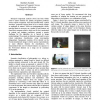Free Online Productivity Tools
i2Speak
i2Symbol
i2OCR
iTex2Img
iWeb2Print
iWeb2Shot
i2Type
iPdf2Split
iPdf2Merge
i2Bopomofo
i2Arabic
i2Style
i2Image
i2PDF
iLatex2Rtf
Sci2ools
113
Voted
ICMCS
2005
IEEE
2005
IEEE
Overcomplete ICA-based Manmade Scene Classification
Principal Component Analysis (PCA) has been widely used to extract features for pattern recognition problems such as object recognition. Oliva and Torralba used “spatial envelope” properties derived from PCA to classify images as manmade or natural. While our implementation closely matched theirs in accuracy on a similar (Corel) dataset, we found that consumer photos, which are far less constrained in content and imaging conditions, present a greater challenge for the algorithm (as is typical in image understanding). We present an alternative approach to more robust naturalness classification, using overcomplete Independent Components Analysis (ICA) directly on the Fourier-transformed image to derive sparse representations as more effective features for classification. We demonstrated that our ICA-based features are superior to the PCA-based features on a large set of consumer photographs.
ICMCS 2005 | Pattern Recognition Problems | Principal Component Analysis | Robust Naturalness Classification |
| Added | 24 Jun 2010 |
| Updated | 24 Jun 2010 |
| Type | Conference |
| Year | 2005 |
| Where | ICMCS |
| Authors | Matthew Boutell, Jiebo Luo |
Comments (0)

